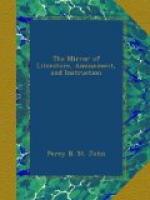Many parts of the abbey are still in a state of tolerable preservation; the marks of cannon-shot and fire are visible on the walls in some places, the abbey having been bombarded by Oliver Cromwell, with his usual zeal against every thing that adorned the country. Many Roman medals of Vespasian, Adrian, &c. have been found about it. I hardly know a more interesting place to visit than Melrose and its neighbourhood; while the abbey affords a fine moral lesson on the instability and perishableness of even the most magnificent works raised by human skill and industry.
“Here naked stand the melancholy
walls,
Lash’d by the wint’ry tempests,
cold and bleak,
That whistle mournful through the empty
aisles,
And piece-meal crumble down the towers
to dust,”
When viewed by moonlight, the solemnity and grandeur of the effect is charming. An enthusiastic friend of mine, on paying the abbey a visit a year or two ago, had it lighted up with tapers. I subjoin a few passages from a letter I received at the time from him;—“Yesterday, being Valentine’s day, in the evening I went to vespers, and had six tapers burning at the high altar in the abbey; also several in each of the (eight) confessionals, holy water, fonts, shrines, and altars.—The church-yard, the abbey, were silent as the grave; you might have heard a pin drop; there was not a breath of air stirring, so the tapers burnt, beautifully.” This must have strongly reminded the spectator of the introduction to the Monastery, and the visit of the worthy benedictine, accompanied by Captain Clutterbuck, for the purpose of taking up his patron’s heart. My friend adds, “not a taper has been burnt in St. Mary’s of Melrose since the days of Knox.—On Monday I went to the tower of Glendearg; at the fountain, where Sir Piercie Shafton and Halbert Glendinning fought, I got, with the help of my guide, some curious stones, said to be the work of the White Lady.” The scenery is picturesque in the highest degree. “Yesterday I went to Old Melrose. The windings of the Tweed there are beautiful; but the tolling the abbey bell recalls me from my wanderings.”




